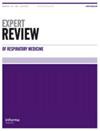Advantages and drawbacks of helmet noninvasive support in acute respiratory failure.
IF 0.9
3区 医学
Q2 RESPIRATORY SYSTEM
引用次数: 2
Abstract
ABSTRACT Introduction Non-invasive ventilation (NIV) represents an effective strategy for managing acute respiratory failure. Facemask NIV is strongly recommended in acute exacerbation of chronic obstructive pulmonary disease (AECOPD) with hypercapnia and acute cardiogenic pulmonary edema (ACPE). Its role in managing acute hypoxemic respiratory failure (AHRF) remains a debated issue. NIV and continuous positive airway pressure (CPAP) delivered through the helmet are recently receiving growing interest for AHRF management. Areas covered In this narrative review, we discuss the clinical applications of helmet support compared to the other available noninvasive strategies in the different phenotypes of acute respiratory failure. Expert opinion Helmets enable the use of high positive end-expiratory pressure, which may protect from self-inflicted lung injury: in AHRF, the possible superiority of helmet support over other noninvasive strategies in terms of clinical outcome has been hypothesized in a network metanalysis and a randomized trial, but has not been confirmed by other investigations and warrants confirmation. In AECOPD patients, helmet efficacy may be inferior to that of face masks, and its use prompts caution due to the risk of CO2 rebreathing. Helmet support can be safely applied in hypoxemic patients with ACPE, with no advantages over facemasks.头盔无创支持在急性呼吸衰竭中的优缺点。
无创通气(NIV)是治疗急性呼吸衰竭的有效策略。口罩NIV强烈推荐用于慢性阻塞性肺疾病(AECOPD)急性加重伴高碳酸血症和急性心源性肺水肿(ACPE)。它在治疗急性低氧性呼吸衰竭(AHRF)中的作用仍然是一个有争议的问题。最近,通过头盔输送的NIV和持续气道正压通气(CPAP)越来越受到AHRF管理的关注。涉及领域:在这篇叙述性综述中,我们讨论了头盔支持与其他可用的无创策略在不同表型急性呼吸衰竭中的临床应用。专家意见:头盔可以使用高呼气末正压,这可以保护自己免受肺损伤:在AHRF中,头盔支持在临床结果方面可能优于其他非侵入性策略,这已经在一项网络meta分析和一项随机试验中得到了假设,但尚未得到其他调查的证实,需要确认。在AECOPD患者中,头盔的效果可能不如口罩,并且由于有二氧化碳再呼吸的风险,使用时应谨慎。头盔支持可以安全地应用于低氧血症ACPE患者,与面罩相比没有优势。
本文章由计算机程序翻译,如有差异,请以英文原文为准。
求助全文
约1分钟内获得全文
求助全文
来源期刊

Expert Review of Respiratory Medicine
RESPIRATORY SYSTEM-
CiteScore
6.80
自引率
2.60%
发文量
90
期刊介绍:
Coverage will include the following key areas:
- Prospects for new and emerging therapeutics
- Epidemiology of disease
- Preventive strategies
- All aspects of COPD, from patient self-management to systemic effects of the disease and comorbidities
- Improved diagnostic methods, including imaging techniques, biomarkers and physiological tests.
- Advances in the treatment of respiratory infections and drug resistance issues
- Occupational and environmental factors
- Progress in smoking intervention and cessation methods
- Disease and treatment issues for defined populations, such as children and the elderly
- Respiratory intensive and critical care
- Updates on the status and advances of specific disease areas, including asthma, HIV/AIDS-related disease, cystic fibrosis, COPD and sleep-disordered breathing morbidity
 求助内容:
求助内容: 应助结果提醒方式:
应助结果提醒方式:


